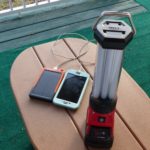by Winding Pathways | Feb 9, 2023 | (Sub)Urban Homesteading, Garden/Yard, Nature, Wonderment
“Yes,” to Geese If You Please
Guest blog by Jody Vrieze
When we lived in Plymouth, Iowa, my husband and I realized there is more to a home than just a house. We embraced our love of nature and animals by creating a retreat in our yard featuring natural diversity and beauty. Our outdoor spaces incorporated annual and perennial flowers, bird feeders, chickens, and Sebastopol geese.
Stay-cations vs. Vacations
A backyard pond featured aquatic plants, and different fish like koi, shubunkin, and goldfish. Raised bed gardens and beekeeping gave us additional duties and joy to enhance our little piece of heaven. Every season brought new activities and treasures. We found that we much prefer quiet stay-cations over vacations!
Perhaps the Sebastopol geese were among my favorites. I would call them by simply saying, “Hi peep peeps!”. They’d be running and following me everywhere. Even as I kayaked! Amazing creatures.❤️
Finding Our Inner Geese Love
Their names are Winston, Willow, and Aspen. When you watch the videos, Winston is always in the lead and Aspen is the smooth-feathered goose. At a poultry swap, we dickered with a man over a pair of Sebastopol geese. We walked away and returned. By then the goose had laid an egg. My husband asked if we could buy that egg and the seller replied, “No, but you can have it.”. The man asked if we wanted the pair of geese we’d dickered about to which my husband replied, “Nope, we have an egg!” We bought pizza, and while eating I cradled the egg to keep it warm. We went right out and bought an incubator. After many adventures of incubator lessons – the right temperature, unplugged or not, and against all odds – on Mother’s Day Lucy hatched.
Winston, Lucy, and Aspen
Winston was added to keep Lucy company. After losing Lucy, a lady brought an egg from a gal in Nebraska to add to the “family”. Even more adventures awaited us with geese. One goose broke her leg and I used our koi pond for rehabilitation.
Winston, the goose, tragically lost several mates and lived to be five or so years old before meeting his demise.
Moving On and Planning Ahead
We have since moved and I’m looking forward to a new coop and some new chickens.
After I was asked to share our adventures for the Winding Pathways blogs, I found that I loved going back through the photos and videos and watching the fun we had.
Now in our new location, we recently had a pair of swans and their cygnet land in our field. They came one morning but are gone now. They must have been planning to hunker down for an impending January snowstorm.
-
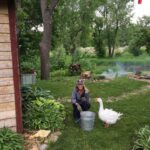
-
What fun to interact with the geese!
-

-
Jody rehabilitated an injured goose in her koi pond.
-
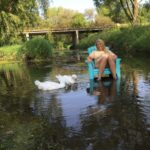
-
The geese flock around Jody in the stream.
by Winding Pathways | Feb 2, 2023 | Foraging, Nature, Pests, Trees, Trees/Shrubs
Disappearing Ash Trees
Ash trees are fast disappearing from American forests and towns. It’s tragic.
There are several ash species, including white, green, blue, and black. A Chinese native insect, the Emerald Ash Borer, is killing them all quickly. It’s awful.
Years ago, Dutch Elm Disease cleared cities of American elms, and many homeowners and towns planted green and white ash trees to replace them. Ashes, in general, thrive in the woods and towns. They grow relatively quickly, resist storm damage, and are beautiful. They seemed like an ideal urban tree.
That was true until Emerald Ash Borers were found in Michigan in 2002, although they may have been around at least a decade earlier. Since then, the insect has spread like crazy, killing ashes radiating outward from Michigan.
They reached Iowa years later and have since killed most of the trees in Cedar Rapids, area woodlands, and many other towns.
Salvaging Ash trees
Rich salvages wood from a scrap pile of used pallets. Pallets are made from cheap wood, like cottonwood, poplar, and hackberry, but now he’s finding ones made of ash.
Loggers are salvaging dead and dying ash trees, and the wood is cheap, at least for now. Soon ash lumber will no longer exist.
A Versatile Wood
Sports fans will miss ash wood. It makes the best baseball bats and has been used for gymnastic bars.
Ash also is crafted into gorgeous furniture.
We lost our big ash tree in the August 2020 derecho, but it was already infested with borers with its days numbered. Sadly, we cut the tree up but gave it a second task. It harvested solar energy and used it to make wood. That wood is now being fed, piece by piece, into our woodstove. It’s keeping our home warm, but we’d rather have our tree.
-

-
Ash bat on oak floor.
-
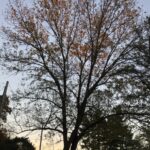
-
The ash tree anchored our east corner of the property.
-

-
White Ash bats will soon be a memory as these elegant trees die.
by Winding Pathways | Jan 19, 2023 | (Sub)Urban Homesteading, Energy Efficiency, Home Improvements, Preparedness
Power outages. They happen in an instant. Most are only a flicker but some can last for hours when the wind’s whistling and the temperature’s dropping outside. Or in summer when the heat rises.
What’s the best thing to do in power outages? Well, it’s best to anticipate it and be ready by having a few things ready to pull out of the closet when the lights go out. Here’s a short list:
Cooking and Food:
- Propane or gas camping stove with plenty of fuel stored away from the main residence. (i.e. in a stand-alone garage) If you live in an apartment or condominium have less volatile fuel options ready.
- A few days of nonperishable or dehydrated camping food.
- Several gallons of water stored where it won’t freeze.
Power Outages and Light & Heat:
Electronics:
- Cell phones and other electronic batteries drain quickly. A backup power source and solar-powered phone charger keep the phone working.
One More Important Item:
- In a widespread power failure credit and debit cards don’t work. Cash always does. Keep some cash in small bills to use during emergencies.
Many other items readily available in case of emergencies help keep life comfortable. Read about them on our other blogs. The list above covers only the most basic and sometimes overlooked, emergency items to keep on hand. Get ready now for power outages.
-
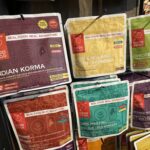
-
We found the meals tasty and filling.
-
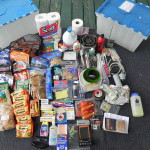
-
emergency food
-
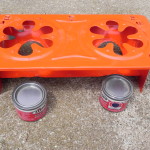
-
This two-burner Sterno keeps food warm but is less useful for cooking. Great for old style fondue parties!
by Winding Pathways | Jan 5, 2023 | (Sub)Urban Homesteading, Garden/Yard, Nature, Trees/Shrubs, Weeds
A raging blizzard roaring over Winding Pathways just before Christmas showed us the power of HARVESTING SNOW. We love catching it.
Well, we didn’t really catch the snow, but our prairie did. It has a talent for harvesting snow and other forms of moisture. It taught us how prairie and other taller plants – grasses, forbs, shrubs, vines, and trees – help themselves grow next summer.
Our prairie has a thick growth of two-foot-tall dead stems from last summer’s growth. Each stalk is brittle, but thousands of them working together slowed the wind just enough for it to drop the snow it had swept off nearby lawns and roads.
The deep drift that settled on our prairie will melt and give next spring’s plants a jumpstart in moist soil. Nearby shortly sheared lawns can’t catch snow and will start the spring on dryer soil. Nature delivered irrigation water to our yard for free!
Nature’s Wisdom in Harvesting Snow
Growing up in the East, we are used to Nor ‘easters that pummel the landscape and create great skiing conditions. Until we moved west, we were not so familiar with how nature replenishes soil moisture, well, naturally!
In dry areas snow also helps next summer’s vegetables. During college, Rich worked weekends at an Idaho ranch. He was surprised one January when Lucille Pratt, part owner of the land and an outstanding vegetable gardener, asked him to shovel snow from a nearby drift onto the garden.
For a Jersey boy, this seemed like a weird request, but melting snow oozed water into the soil. That helped get the vegetables going and sustain them through the dry summer.
Snow may seem like a bother but it’s also a blessing to dry soil and the plants it sustains.
Over two blizzardy days, our prairie gently caught snowflake after snowflake. We already are looking forward to bright prairie flowers dancing in next summer’s breeze. Thanks, prairie for harvesting snow. Nature’s wisdom to catch winter’s snow and help next summer’s growth is amazing.
-
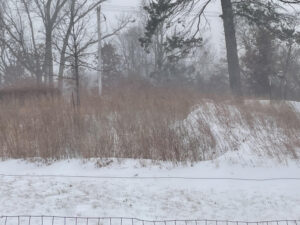
-
Capturing snow.
-
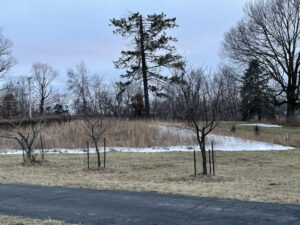
-
Three days later, a rapid melt left the ground bare, except where prairie plants held snow.
by Winding Pathways | Dec 15, 2022 | Birds, Garden/Yard, Nature

A chickadee gently cradled in man’s hand.
On an early, warm, bright November day, several Coe and Mt. Mercy University Students with their professors arrived at Winding Pathways to band birds. They stood mesmerized as one cradled a diminutive bird in his hand. This long-distance traveler had met a temporary misfortune.
It was a golden-crowned kinglet, a tiny bird tipping the scales at only .19 ounce. On a recent night, it had winged south from its summer home in the north and decided to rest and feed amid the tall grass and woods at Winding Pathways. Then, it would continue southward. It didn’t know that Dr. Neil Bernstein had other plans.
-
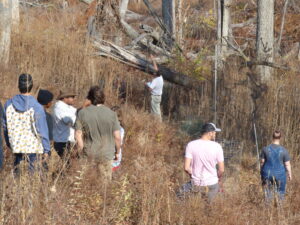
-
Dr. Bernstein sets a mist net by a fallen log.
-
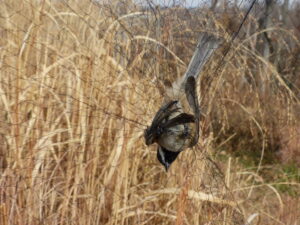
-
trapped chickadee
-
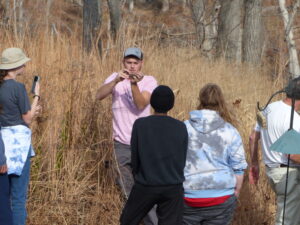
-
Untangling bird
Neil had stretched mist nets an hour earlier. The kinglet, along with chickadees and a Carolina wren didn’t see these fine mesh nets in time. They were caught but uninjured. Neil showed the students how to band birds by gently removing them from the net, weighing each tiny bird, recording data, placing a small lightweight band around its leg, and releasing it. Data are then submitted to help researchers better understand bird migration.
The kinglet and wren waited patiently as students weighed and banded each, but not the chickadees. These bitty, year-round residents have an attitude. They didn’t like being held one bit and pecked at the student’s fingers.
-
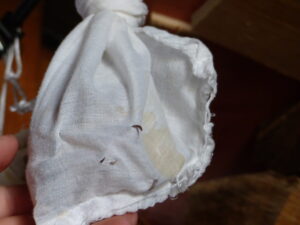
-
A bird’s claws poke through the bag.
-
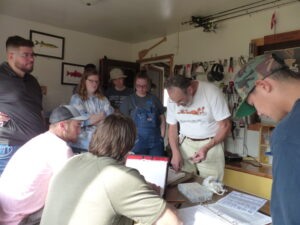
-
Verifying information is important.
-

-
Tiny band ready to attach to a bird
-
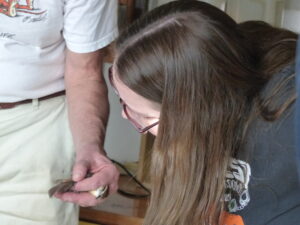
-
Checking feathers
Student Reactions
Students were used to collecting scientific data on different natural topics. They were fascinated by the process of banding birds. “I thought we were going to listen to a bird band!” joked one student. Another envisioned running around chasing birds, concluding that would not work well.
Students commented on how the pecks were sharp but not worrisome. One explained she talked quietly to the chickadee as she carefully held it. Reassuring the bird, she would not hurt it. “I could feel its heart rate slow down,” she commented.
Although chickadees are small, kinglets are even smaller. This kinglet will carry its band as it wings southward but chickadees are homebodies and will wear their bands as they flit around our yard all winter.
Why Band Birds?
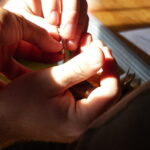
Tiny band with a number.
Banding is a traditional way of learning where birds go, habitat needs, and the impact of climate on both. Perhaps a fellow bander will catch “our” kinglet and inform scientists at the US Geological Survey.
by Winding Pathways | Dec 8, 2022 | Garden/Yard, Mammals, Nature, Travel/Columns
Fair Oaks Farm
A couple of times a year we drive to and from New Jersey to visit relatives. It’s a long thousand-mile slog each way, but we recently discovered an amazing driving break……watching a calf being birthed.
Our fastest route is following Interstate 80, but that involves running a traffic gauntlet in northeast Indiana and paying tolls and boredom along the Ohio and Indiana Turnpikes. On a recent trip, we took a more southern route, mostly following secondary roads to avoid tolls and traffic. Never would we have imagined that, on a driving break, we’d watch a birth!
Cow Adventure
Yup. A birth. We’d been following smallish roads across the Hoosier State and had vaguely heard of Fair Oaks Farm. As our car cleared a rise by an enormous farm field we spotted their colorful water tower and stopped in. It’s really not a farm…but then again it is. Mostly it’s a fascinating living museum of American agriculture, focused on dairy, pork, and crops combined with a hotel, restaurant, and gas station.
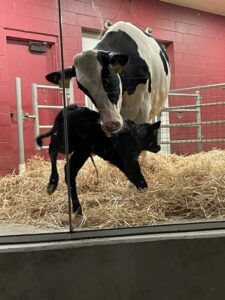
Wobbly legs
After checking in we entered the birthing barn to take in an amazing sight. Two Holstein dairy cows were giving birth, with a human attendant attentively watching to help as needed. As we sat with other families in the darkened seating area, two hooves emerged from each cow. One gave birth quickly. The other struggled until the attending woman helped by gently pulling the calf from her. We, and many others watching, were riveted by the real-time arrival of new living animals. This event brought to mind Marion’s experience growing up on a Maine dairy farm watching a calf being birthed.
From there we enjoyed exhibits telling the story of how crops are grown, dairy cows are cared for, and pork is produced. We walked from building to building enjoying interactive exhibits telling the story of food production. The Farm calls the exhibit areas Crop, Dairy, and Pig Adventures – and they truly are adventurous.
Ninja Warriors in Training
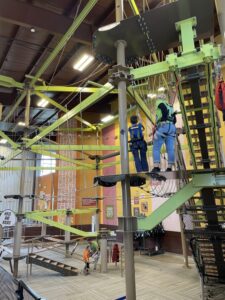
Kids on ropes course
At Pig Adventure we encountered a couple with two small children. “We were on a long drive from Indianapolis to Chicago. The kids were restless in the back seat. So, we stopped. Look at them now,” declared their mom. A young boy and girl were testing their balance on a large complex obstacle course sort of like we see on TV’s American Ninja Warrior. They were harnessed in and guided by employees. Thrills and exercise, yes. Danger, no.
As a seasoned museum professional Rich was impressed at how exhibits were accessible for walking-challenged folks with plenty of places to sit and rest. Yet they gave kids a chance to burn off energy as they moved from exhibit to exhibit. For example, kids could climb small “hills” and slide down the other side to see new displays. One boy operated a hand crank to move large constructed kernels of corn up a vertical elevator to drop into a “silo” and back down for kids to repeat the process. Great learning combined with physical activity. It was, for the family, an educational and exciting way to burn off energy.
Take Time to Experience
We are far from being kids but we gave the crank some turns, also. Then we took a tour break and enjoyed lunch at the site’s eatery, called the Farmhouse Restaurant. As we dined, we watched cheese being made behind a huge glass wall.
We could have boarded a shuttle bus to see actual dairy and pork operations nearby or walk to the orchard and pumpkin patch but time was pressing. We needed to hit the road. So, we will be back.
Visionary Beginnings
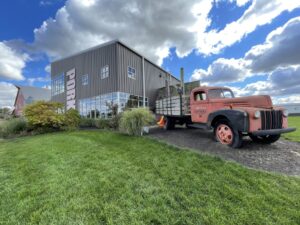
Pig Adventure Starts here!
Fair Oaks Farm was the dream of Mike and Sue McCloskey who began creating it in 1999. It opened a few years later and new exhibits – actually agricultural adventures – are regularly added. Today about 275 staff host thousands of people every year. Jobs for local teens, parents, and grandparents as they warmly welcome visitors.
It’s not all pigs and cows. Many people visit the orchard in the fall to pick apples or the pumpkin patch to stock up on the orange globes for Halloween. Later in the season, there’s ice skating, a forest of lights, and even igloos to enjoy.
The Farm is just off Interstate 94, which links Chicago and Indianapolis. Anyone driving East/West might consider taking smaller roads that parallel Interstate 80 for a less stressful drive that leads past the Farm. For information check out fofarm.com.







